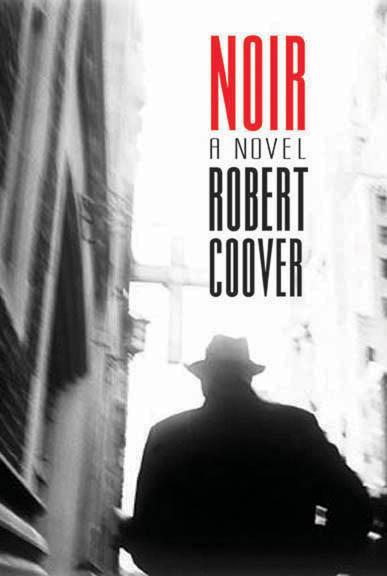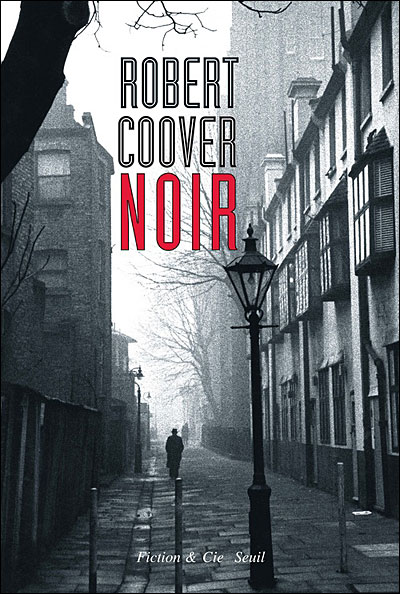.
.
To borrow the second person voice (“you”) that controls the narrative of Robert Coover’s new novel, “Noir”, let it be noted at the outset that you fall within one of three groups.
1 – You are a Coover aficionado and have read most or all of his output to date. You will buy or borrow the newly released “Noir” and read its slim 192 pages in a feverish swoon, critics be damned. If, at some point, you find yourself reading reviews of “Noir”, it’s because you’ve finished the book and want to relive the experience or compare your reaction to others. For you, there are comments further below.
Or:
2 – You have read one or two Coover books (maybe as part of a post-modern lit course) and want to catch up with what the 78-year-old author is doing nowadays. Is he still in the game, you wonder? The news is positive. You will find the pages of “Noir” spellbound by Coover’s signature mordant wit and claustrophobic worldview. Elsewhere you may have come across the much repeated statement by NY Times book critic Michiko Kakutani: “Of all the post-modernist writers, Robert Coover is probably the funniest and most malicious.” So, yes, you’ll find “Noir” fitfully laugh-inducing — especially if you’re in the mood for a relentless, demented, hallucinogenic parody of crime fiction. If at its end you are still ambivalent about the book, well, that it not uncommon with Coover. At its close you may place a hand on your belly and think to yourself, that was not so much a satisfying meal as a bitter entrée. Or, you may be so delighted by its denouement, incorporating street philosophy, word play, puns, double entendres and all-around cleverness, that you will forgive being dragged through some slow sections.
Or:
3 – Coover is entirely new to you. If so, you are wondering how do you get a good sense of what “Noir” will mean to you as a reading experience? You’re finding most reviews of the book are frustratingly un-useful to a novice reader. (There seems to be a jargon-loving Coover clique that luxuriates in the cryptic.) Well, you might consider first checking out a short interview in which Coover himself explains the style and themes of “Noir”. This is available online (use these three words in Google search: Coover bookslut interview). Consider also spending a few minutes watching Coover in action, as he reads an early scene (and arguably the best pages) from “Noir”. The video is available using four terms in Google search: Coover Penn Reading Video. (His reading from “Noir” occupies the final minutes of the QuickTime video). If the interview and video generally pique your interest, and if you would not be put off by what is essentially a light entertainment somewhat burdened with down and dirty stretches of bleak pessimism and erotic haunting, then by all means read “Noir”. Or, consider one of the following alternatives to “Noir” as a better first experience of Coover: “Pricksongs and Descants”, his ground-breaking short story collection; or “The Origin of the Brunists”, a conventionally generous and very American tale of the spawning of a religious cult in a mining community; or, if you can find a used or library copy of “A Political Fable: The Cat in the Hat for President” (unfairly, it is currently out-of-print). “A Political Fable” may very well become your favorite piece of zaniness by any author ever. It is mine.
Finally, here are a few stray perceptions of my own to share with Coover fans who have finished the book.
Coover is nothing if not quotable. Wherever you are in “Noir” you are not far from coming upon yet another comment on humankind’s bleak condition. Coover spins endless variations on an astringent melody whose lyrics tell of “your incorrigible weakness in a meaningless universe” (page 103), a ballad “meant to provoke reflections upon life’s brevity, and its thin sad beauty” (page 108). Other examples: “It’s not the story you’re trapped in but how you play it out … your style … steppin’ round the beat … How long does that matter? As long as you live, meaning, no time at all.” (page 52). “What’s the connection? No idea. Connections [are] probably an illusion in such a fucked-up world as this. Why you’re down here. Illusory connections” (page 113). “The city was as bounded as a gameboard, no place to hide in it, no way but one to leave it, you alone defenseless in it, your moves not even your own” (page 175). Most Hobbesian of all is this: “The body has to eat and drink so it can stay healthy long enough to enjoy an agonizing death, and the mind, to help out, has to know where the provisions are and how to get them and who else is after them and how to kill them” (page 159). The novel’s close brings a softer tone: “You can’t escape the melody but you can make it your own.”
Especially at the novel’s climax, borrowings from films are abundant: the shifting cityscape of “Dark City” (page 163), the mirror room scene in “The Lady from Shanghai” (page 181), and the false-identity caper “Catch Me If You Can” (page 186).
At one point Philip Noir tries to recall who once likened an odd juxtaposition to “a pearl onion on a banana split.” This is a line used by Raymond Chandler’s Marlowe. When another character advises, “Plant you now, dig you later, man” (page 111) , this is a twofer or maybe a three-way: its source is the jazz world of the 1920’s/30’s, but the phrase also was used as a title of song in “Pal Joey” and later as the title of a “Gilligan’s Island” episode — facts surely not lost on pop culture maven Coover. Other more careful readers (with or without benefit of Google search) will best me in this endless game of spot-the-allusion, but final mention should be made of one “high culture” reference I spotted, a reference that informs the musical ambiance of the book. Philip Noir notices a few words carved into the wooden tabletop at a jazz joint: “You are the music while the music lasts.” This is a line from “The Dry Salvages”, the third section of “Four Quartets” by T.S. Eliot.
I wonder whether the sympathetic character of Michiko (“she’s a work of art”) is Coover’s homage to the sympathetic critic of his work, Michiko Kakutani. But, given the fate Coover confers on the fictitious Michiko, I’m thinking maybe this is best left unexplored. As the author himself cautions:
“It’s all quite simple. But sometimes not knowing is better. It’s more interesting.”
.
.
One final observation (to be filed under “Annoyances, Petty”): The covers of both the American and French editions of the novel sport photos that are at odds with the story. Both photos are of daytime scenes of a walker in a city. But the perambulations of Philip Noir take place entirely at night. Does the discrepancy matter? Probably not, but wouldn’t it be nice if the photographer, or the editors who selected the final images, had actually read the book?
(A version of this review appears on Amazon.com, here.)
.

